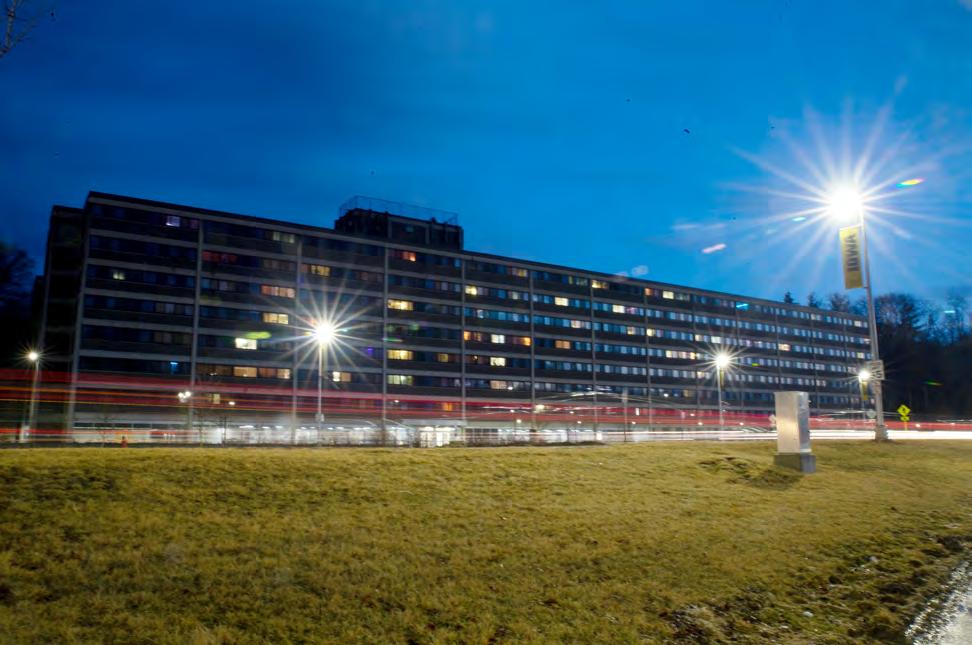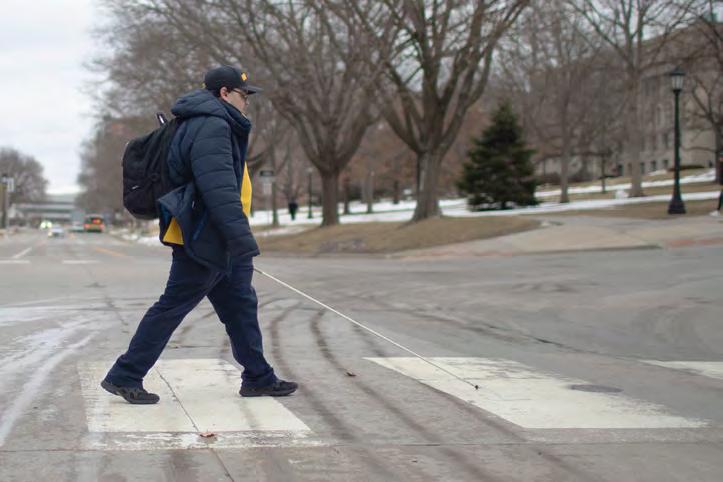
7 minute read
UI music therapists celebrate growing field
Music therapists in Iowa City gathered during Music Therapy Week to emphasize the importance of their work.
Sofia Mamakos News Reporter
Advertisement
Kelly Carlson knows how music can change people’s lives.
Carlson, a visiting professor and doctoral student at the University of Iowa studying musical therapy, has worked as a music therapist for 18 years.
“I get the chills on a weekly basis just seeing how music touches people,” Carlson said. Carlson is also the vice president of the Midwestern Region of the American Music Therapy Association.
Carlson said she works mostly in hospice where she provides patients with music therapy to help them feel relaxed and at peace.
“Somebody who might be really stressed and anxious — maybe has dementia and maybe doesn’t know where they’re at or who anybody is — but they will still sing complete songs with me and dance and smile and just light up,” Carlson said.
“That’s priceless to me.”
Music therapists at the UI are celebrating their growing profession during national Music Therapy Week, which is from Feb. 26 to March 4.
Music therapy is the use of music to help patients by lowering stress, reducing pain perception, and improving patients’ moods through self-expression. Music therapists develop music-based treatment programs where participants listen to music, sing, play instruments, and compose their own songs.
According to the American Music Therapy Association, the demand for music therapy in the U.S. has doubled in the last five years. Additionally, the Music Therapy Market has seen increased popularity as an effective physiological treatment.
UI researchers work with neighborhood center kids
The lab analyzes language learning for bilingual children.
The research project is being conducted through the Clinical Linguistics and Disparities Lab, where Combiths serves as director.
The Neighborhood Centers of Johnson County is an organization focused on offering before and after school programs for children in areas throughout the county.
The pilot program tracks and analyzes the preschoolers — who speak Arabic, French, Spanish, Lingala, and Swahili — at the centers and how their English as a second language skills develop.

The current program started when Combiths arrived in Iowa in 2021 as an assistant professor and started a collaboration with the centers through one of his classes, he said.
“We had a class for our graduate students who were studying to become speech language pathologists,” Combiths said.
“Our students would go into the centers and work with the teachers in the classroom to create an individualized sort of support plan for one of the kids in their classroom for whom they had some language concerns.”
While graduate students gained experience, and the neighborhood centers enjoyed having UI students, it put a strain on the K-12 teachers to swap out graduate students each semester and re-teach them school protocols, he said.
“So, the thought was, let’s address some of the questions and problems like challenges you’re facing here through a research project, and what’s nice about that is it’s couched in my lab and a research project is continual,” Combiths said. The research project, Combiths said, revolves structional professor and coordinator of clinical activities in music therapy, said she has seen the profession grow.
“Music therapy is an evidence-based profession that’s growing in its ability to serve and the willingness of people to engage in music therapy in their communities,”
Nelson said.
Aside from teaching at the university, Nelson has been a clinician in music therapy for 18 years.
“I love the way music brings people together, and I really love the way music creates connection between people,” she said. Nelson said she was able to celebrate this week with a number of music therapists in Iowa City. “We had a gathering yesterday of music therapists because we are all from different places,” she said. “We’re just very fortunate to have 20-plus certified music therapists around language sampling of the children in addition to information gathered from parents at home to track language development.
Researchers conduct language sampling by recording a child speaking and transcribing their words into code. That code is then analyzed by a computer to see what words are used correctly compared to errors.
Jana Garrelts, Neighborhood Centers of Johnson County director of child care and learning programs, said there are over 100 kids at the centers each day, and 92 percent of
The Daily Iowan
in this area.”
UI first-year music therapy student Laura Kuper is also getting involved with the festivities. Kuper wrote in an email to The Daily Iowan that she decided to study music therapy to com- the families speak another language at home.


Through an event in the fall, Garrelts said the centers equipped families with books written in their native language and encouraged them to continue speaking that language with their children at home.
“Parents really found that to be a helpful thing because I think they struggle with that a little bit — whether to speak in English and improve their children’s English or to speak in their home language — and it was almost like giving them permission,” Garrelts said.
Garrelts said the parents are interested in continuing the study to bine her love of music with helping others. “I saw how music can cause miracles to happen,” Kuper wrote. “For example, I played a song for people with moderate-severe dementia, and they could remember the see where their children’s language development skills are and how their English language skills can develop.
“I’d be anxious to see what we get with the research and the data with that,” Garrelts said.
Emily Hartman, a fourth-year undergraduate student studying communications sciences and disorders, is in charge of designing the lab’s aims, questions, and goals in addition to teaching other members how to use the data program, Systematic Analysis of Language Transcripts, for the study.
“There are all these rules for how we would code it. And then the computer would read those lyrics, though they could not remember their own birthday.” For her first year of Music Therapy Week as a future therapist, Kuper wrote she will find time to appreciate the profession. codes and tell us all this information about it, and so I’ve trained myself in that and then generated conventions on how to train other people in that,” she said.
The computer’s analysis can help identify struggle areas for children, Hartman said.
“Then, when you work with the child, if there are still struggles that the child has, it could be indicative that the child needs referral for further help from a professional,” she said.
The lab also implements a multi-tiered system support model in the English education classrooms in the centers, she said.
Combiths said the sup-
“I will take more pride in my work, and I will give my professors (who are amazing music therapists) an extra ‘thank you’ for all they do,” she wrote.
Carlson said she hopes to make an effort in speaking out about her profession.
“During Music Therapy Week, I tend to go out of my way to do more advocacy for music therapy,” she said.
Carlson said she wants port model assists with questions that arise in a bilingual educational environment. to stress the effectiveness of music for non-musical things like social coping skills, relaxation, pain management, and even rehab from traumatic brain injuries. sofia-mamakos@uiowa.edu
For example, a student in their first exposure to English may be exposed for four months and still not speak at the level expected. It can be difficult then to determine whether it’s an issue of speech or an issue of dual language learning, he said.
In these scenarios, there is often too much information gathered about their English language skills and not enough about their native language skills, which can lead to inaccurate conclusions about language learning difficulties, Combiths said.
“It’s just something that people don’t typically think of right off the bat, but it is a proven and evidence-based profession that can provide a lot of good for a lot of people,” she said.
“With this tiered process, you don’t have to make that clinical decision immediately all the time before helping them,” he said.
The tiered process also allows for more undergraduate participation, Combiths said.
“We’re working on … activities to do with the children. You know, language tasks to do with them to both assess their language abilities and but also to support them in ways that are like in a general education environments,” Combiths said. “These don’t require like clinical skills like a graduate student would have.” archie-wagner@uiowa.edu
JoCo Public Health shifts COVID-19 mitigation perspective
of COVID-19 management after the state announced plans to end mandatory minds for a long time now.

“The federal administration had mentioned that they would provide 60 days notice and begin to signal when that would be and what that would look like for all of us,” Jarvis said. “And so, I imagine for the last couple of weeks, two months, a lot of us have been kind of wondering what those details look like.”
The department said the type of COVID-19 re- the announcement was coming, it was still difficult to believe after having combated the pandemic for the past three years.
“It’s so hard, I think, to acknowledge, especially when so much of your time and your work over the last three years has been so involved with COVID response,” she said. “And so, kind of having it come to an end, it’s a little jarring. But also at the same time, It’s a relief which a lot of items it sounds like will be — and we’re happy to hear that,” Jarvis said. “Our biggest concerns, from our perspective … is really where and how vaccines and therapeutics will be handled going forward.”
For the Johnson County Public Health department, Pettit-Majewski said it would continue to provide the best service it could for the community and provide whatever resources it could.

Pettit-Majewski and Jarvis both said they were thankful to the community for their cooperation with county public health, citing the relationship as a key factor for keeping the county safe.
Pettit-Majewski said even though the county public health department knew
“I think what would be best to focus on is what is still going to be in place,
“Johnson County has the highest vaccination rate in the state, and that doesn’t happen by accident,” Pettit-Majewski said. “I can’t thank them enough for listening to guidance, for masking, for doing all of the things that saved lives over the past three years.”









